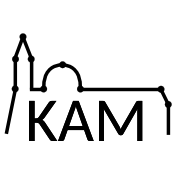Mathematical Analysis I
This is a basic course in real analysis targetted at first year Bachelor students. Exercises are led by Dr. Andrew Goodall.Organization
The lectures take place on Thursdays at 12:20 in the lecture room S11. The final grade for the course will be based on an exam at the end of the sememster. You must obtain a "pass" in the tutorial to be able to take the exam for this course.Syllabus
Follow the notes By Aleš Pultr to see the basic content of the course. The following is a list of Books and their chapters that I will use for the lecture. (The list will be updated as we go along).
| Understanding Analysis | by Stephen Abott | Chapters 1,2,8.4,3,4,5 |
Material Covered in the Lectures
October 08: Elementary Logic; Quantifiers \(\forall, \exists\); Connenctives \(\lnot, \lor, \land, \Rightarrow,\Leftrightarrow\); Types of proofs - induction, contradiction, case analysis,\(\ldots\); proof that \(\sqrt{2}\) is irrational; Basic set theory \(\cup,\cap,\setminus\); Russell's Paradox; Cartesian product of sets; Functions as sets; Domain and Range of a function; Equivalence relations.
October 15: Motivation for defining real numbers (holes in rationals); desired properties of reals - addition, multiplication, existence of inverses, commutativity, associativity, distributivity; Fields; Ordering; Axiom of Completeness: bounded \(\implies\) existence of least upper bound; Definitions: bounded above, upper bound, least upper bound (supremum); uniqueness of suprema; maximum; Construction of reals via Dedekind cuts; Dedekind cuts: definition; order define via the relation "\(\subseteq\)"; Algebra over Dedekind cuts: addition, negation.
October 22: Dedekind cuts: (addition, negation), multiplication; Real numbers (the set of Dedekind cuts with alegbra and order as defined) satisfy the Axiom of Completeness; Density of \(\mathbb{Q}\) in \(\mathbb{R}\): Archimedian property, Thm: There exists a rational number between any two distinct real numbers; countable sets; Example: set of even numbers; \(\mathbb{Q}\) is countable; Nested interval property.
October 29: Uncountability of \(\mathbb{R}\); Sequences of real numbers as functions \(f:\mathbb{N}\to\mathbb{R}\); Convergence; limit; uniqueness of limit if one exists; Bounded sequences; comvergence implies boundedness; algebraic theorem for sequences and their limits: \(\lim (ca_n), \lim(a_n+b_n), \lim(a_n\cdot b_n), \lim\left(\frac{a_n}{b_n}\right)\); If \((a_n),(b_n)\) are sequences with limits \(a,b\) then \(a_n\geqslant 0 \implies a\geqslant 0\), and \(a_n\leqslant b_n \implies a\leqslant b\), and \(a_n\leqslant c \leqslant b_n\implies a\leqslant c \leqslant b\) for real \(c\); Squeeze theorem; Increasing/decreasing/monotone sequences; monotonicity and boundedness together imply convergence; Subsequences (definition).
November 05: Subsequences of a convergent sequence converge to the same limit; example: \(b,b^2,b^3,\ldots\) for \(0 < b < 1\); Bounded sequences contain a convergent subsequence; Cauchy sequences; A sequence is Cauchy if and only if it is convergent; limit superior/inferior; Introduction to series; definition of convergence of series; example \(\sum_{n=1}^\infty\frac{1}{n^2}\).
November 12: \(\sum_{i=1}^\infty\frac{1}{n}\) diverges; Cauchy condensation test: \(\sum_{n=1}^\infty a_n\) converges if and only if \(\sum_{n=0}^\infty 2^n a_{2^n}\) does; application of Cauchy condensation test: \(\sum_{n=0}^\infty \frac{1}{n^p}\) converges if and only if \(p>1\); Algebra of convergent series: \(\sum_{n=0}^\infty ca_n=c\left(\sum_{n=0}^\infty a_n\right)\), \(\sum_{n=0}^\infty a_n+b_n=\left(\sum_{n=0}^\infty a_n\right)+\left(\sum_{n=0}^\infty b_n\right)\); Cauchy criteria for convergence; Application: \(\sum_{n=0}^\infty a_n\) converges then \(\lim a_n=0\); Comparison test; Example: \(\sum_{n=0}^\infty\frac{1}{n!}\); Absolute convergence test; Inverse of absolute convergence test not true: \(\sum_{n=1}^\infty(-1)^{n+1}\frac{1}{n}\); Leibniz/Alternating series test; Rearrangements of absolutely converging series converge to the same limit.
November 19: Ratio test for convergence; Example: \(\textrm{exp}(x):=\sum_{n=0}^\infty\frac{x^n}{n!}\) is a well defined function for every \(x\in\mathbb{R}\) with the convention that \(0^0=1\); Multiplying series; Product of two absolutely convergent series converges to the product (without proof); Power series; Multiplication of power series; Proof that \(\textrm{exp}(x+y)=\textrm{exp}(x)\cdot\textrm{exp}(y)\); Proof (sketch) that \(\textrm{exp}(x)=e^x\) for all \(x\in\mathbb{Q}\); Definitions: \(\epsilon\)-neighborhood, limit point, open/closed set; limit points of a set are equivalent to the limits of sequences of points from the set.
December 03: Definition of functional limits: \(\epsilon{-}\delta\) version, topological version; functional limits as limits of arbitrary sequences; Algebraic limit theorems; Divergence critera: \(\lim_{x\to c}f(x)\) does not exists if two different sequences converging to \(c\) produce different limits; Example: \(\lim_{x\to 0}\sin(1/x)\); Squeeze theorem; Definition of continuity: four equivalent definitions; criteria and types of discontinuity; Algebraic continuity theorem; Application: Rational functions are continuous wherever they are defined; composition of continuous functions; Definitions: (strictly) monotone, periodic, odd, even, (global/local) maximum/minimum.
December 10: Intermediate value theorem; image of an interval is an interval for continuous functions; continuous functions attain maxima and minima over closed intervals; monotone and interval image implies continuity; continuous functions are invertible if and only if strictly monotone, and the inverse is continuous; Definition: derivative, differentiability; some examples; Differentiable implies continuous; Interpretation of derivative as a means for linear approximation; example: estimating \(\sqrt{1.1}\); algebraic theorem for derivatives; (Chain rule) derivative of composition.
December 17: At points of extrema in an open interval, the derivative is zero; derivatives satisfy intermediate value theorem (without necessarily being continuous); Rolle's theorem; Mean value theorem; Generalized mean value theorem; Application: the only functions with zero derivative are the constant function; L'Ĥopital's rules.
January 07: Taylor polynomial; Lagrange remainder theorem; Application: better estimates for functions; Example: \( \sin{x}\); Example with a "useless" Taylor expansion \( e^{-1/x^2} \).
January 14: Non-negative derivative implies (increasing) monotonicity; Convex/concave functions; \(f \) convex if and only if \(f^{''}(x)\geqslant 0\); second derivative test for maxima/minima.
End of Lectures.
